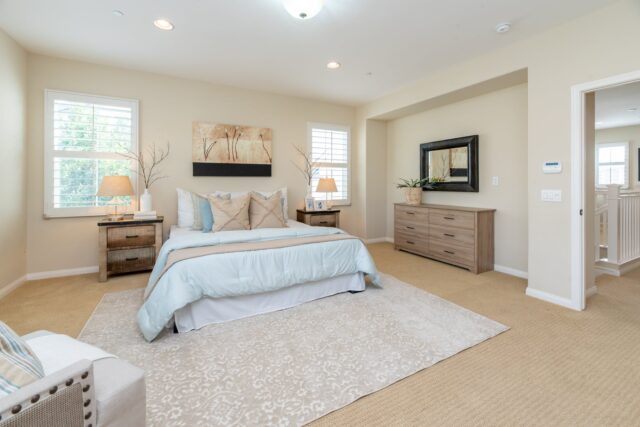
If you find yourself drinking coffee all day because you barely got any sleep during the night, you are not alone. According to the American Sleep Association, 1 in 3 adults report symptoms of short-term insomnia, while 1 in 10 has chronic insomnia. Many factors can lead to sleep issues, and your bedroom may be part of the problem.
Creating the ideal sleeping environment is above all, an exercise in restraint. Absence of electronics, clutter or reminders of work stress, appropriate lighting, muted color palette, and appropriate bedding can make a dramatic difference in how easily you fall asleep and how rested you feel in the morning.
1. Avoid Clutter
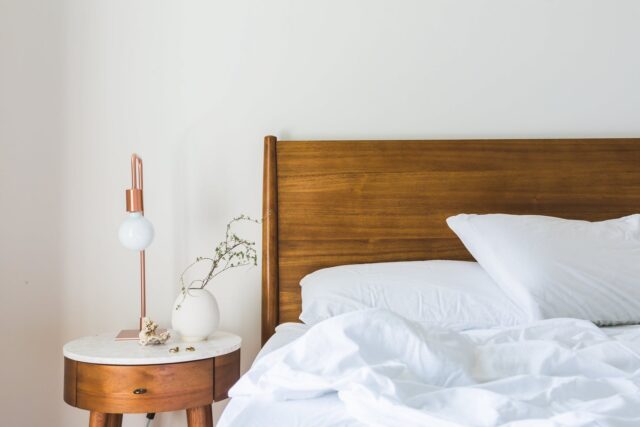
A cluttered bedroom is not just a big Feng Shui no-no, but it can also lead to anxiety and negatively affect the quality of your sleep. Taking the time to declutter your bedroom will simplify everything and make it easier to focus on sleep instead of reminders of uncompleted tasks. Plus, you’ll stop tripping over things in the middle of the night.
You’ll first want to remove stacks of bills, work papers, electronics, exercise equipment, unfolded laundry, or anything that doesn’t belong in the bedroom. The rest you can hide away in the closet, or, if there isn’t enough space, you can make your own storage solutions with some shelves, baskets, bulk ribbon, and imagination. You can get the ribbon from TheRibbonRoom and for imagination, you have to look within. The idea is to keep things out of sight so you can minimize the visual clutter, which is what causes that feeling of uneasiness. We also tend to put a lot of things on the nightstand so you’ll want to put them in the drawers or in a basket. On top of the nightstand, you should keep only a lamp, an aesthetically appealing bottle of water, a book, and a journal.
2. Choose a Soothing Color Palette
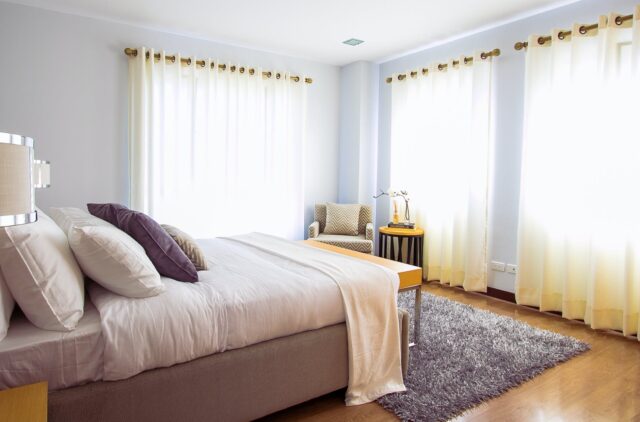
Bright tones and intricate patterns can be fun, but it’s better no to use them in the bedroom. Instead, opt for muted shades of blue or green that are more soothing and sleep conducive. Cool colors lower heart rate and blood pressure and help you fall asleep faster. One survey with 2,000 responders found that people who slept in bedrooms with a blue color palette averaged 7 hours and 52 minutes of sleep per night. Purple bedrooms, on the other hand, were found to be the least favorable to restful sleep.
Dark walls in a small bedroom can make it feel claustrophobic, but they make it easier to sleep during the day, so if you work shifts, you may want to try it. Regarding the finish, flat paint is better than glossy because it makes the colors look softer and more calming.
3. Dim the Lights

Our circadian rhythm, commonly referred to as internal clock, uses external stimuli such as light to regulate the production of hormones that induce sleep. In other words, too much light in the bedroom will affect your ability to get a good night’s sleep. In case you live in an area that’s particularly bright in the evening, we recommend you get some heavy curtains that will also help with noise.
It would be best if you also refrained from using any electronic devices such as laptops, tablets, or smartphones two hours before bedtime because the blue light emitted by the screen interferes with the production of melatonin – a sleep hormone. If you have a habit of falling asleep while listening to the TV, you can listen to an audiobook instead, but set it to stop playing after 30 minutes, so it doesn’t interfere with your sleep.
4. Keep it Quiet
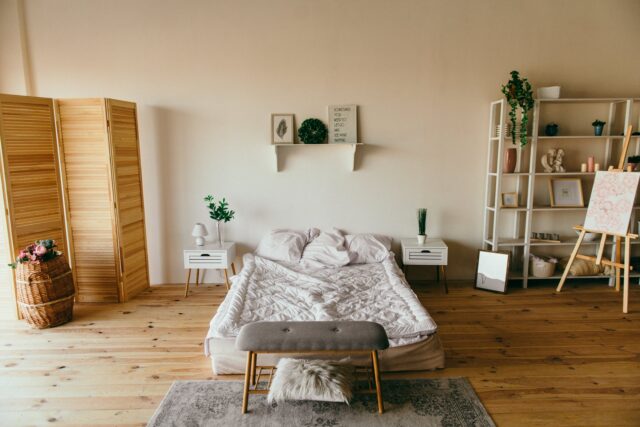
While we’re sleeping, we continue to process background noises, so the TV or audiobook you left on can interfere with your sleep stages, and although you may not wake up completely, you can come of the deep sleep stage. Noise from the street and notification on your phone will have the same effect.
This means you’ll want to sound-proof your windows and switch your phone to silent mode. Rugs also help reduce noise, especially if you have hardwood floors.
White noise, in contrast, has been shown to make people fall asleep more easily and tune out some of the sudden noises that disrupt sleep architecture. A ceiling fan or a white noise machine might be just what you need.
5. Make Sure Your Bed Is Comfortable
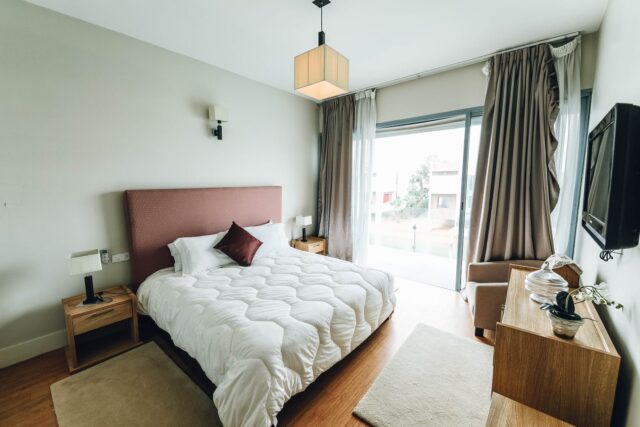
This might seem obvious, but it’s an often overlooked aspect. The quality of your mattress, pillows, and linen will affect how well you sleep.
A sagging or lumpy mattress will make you move during the night as you’re trying to find a comfortable position. In the morning, you’ll feel tired and have back pain. Considering how important sleep is to health and productivity, you might want to consider getting a good quality mattress. This is easier said than done. A mattress can be a rather expensive purchase, so you’ll have to do some extensive research. Luckily, a good quality mattress should last about ten years.
Once you’ve decided on a model, it’s time to head to the store and test it out. This will also give you an idea of what size you need. Especially for couples that have recently moved in together, the problem is that the mattress that used to be big enough for one person is now too small and uncomfortable. You’ll be waking up twice as often because every time your partner moves, they’ll make your side of the bed move as well. Don’t be afraid to lie down on the mattress in the store; it’s common practice. Plus, you’ll also have a 30 or 60-day guarantee to see if you’ve made the right choice.
Your pillows are also important to your sleep since they provide support for your head, neck, and spine. Most people sleep on their side, and in that case, we recommend you place a pillow between your knees as well to keep your hips and spine in alignment.
Otherwise, you’ll notice that you keep waking up to switch on the other side because you’re getting uncomfortable.
A pillow should be changed every 18 months, but foam pillows tend to last longer. If you’ve been using the same ones for 5 or 6 years, they’re probably worn out, and you need to scrunch them and fold them to get adequate support.







